NZDB Level 5: Managing Organizational Culture - A Chorus Case Study
VerifiedAdded on 2023/06/04
|13
|2934
|448
Case Study
AI Summary
This case study provides an in-depth analysis of organizational culture management within Chorus, a network and broadband servicing company, focusing on strategies to enhance the internal environment and improve employee management. The methodology involves stakeholder analysis using models like the Mitchell Model and the resource relations balance model to assess stakeholder positions and resource exchange structures. The study examines learning within Chorus at both individual and organizational levels, incorporating behavioral, cognitive, and constructive theories, along with an analysis of attitudes, behavioral traits, ethics, and professional behavior. Leadership styles, power politics, and the overall organizational culture are explored, identifying strategies to demonstrate ethical and professional behavior that is socially and culturally appropriate. The analysis also covers the identification of internal and external stakeholders, the creation of a power-interest matrix, and the determination of resource relations between Chorus and its stakeholders, culminating in an evaluation of the admissibility of the company's strategy and recommendations for fostering a more positive and productive workplace.
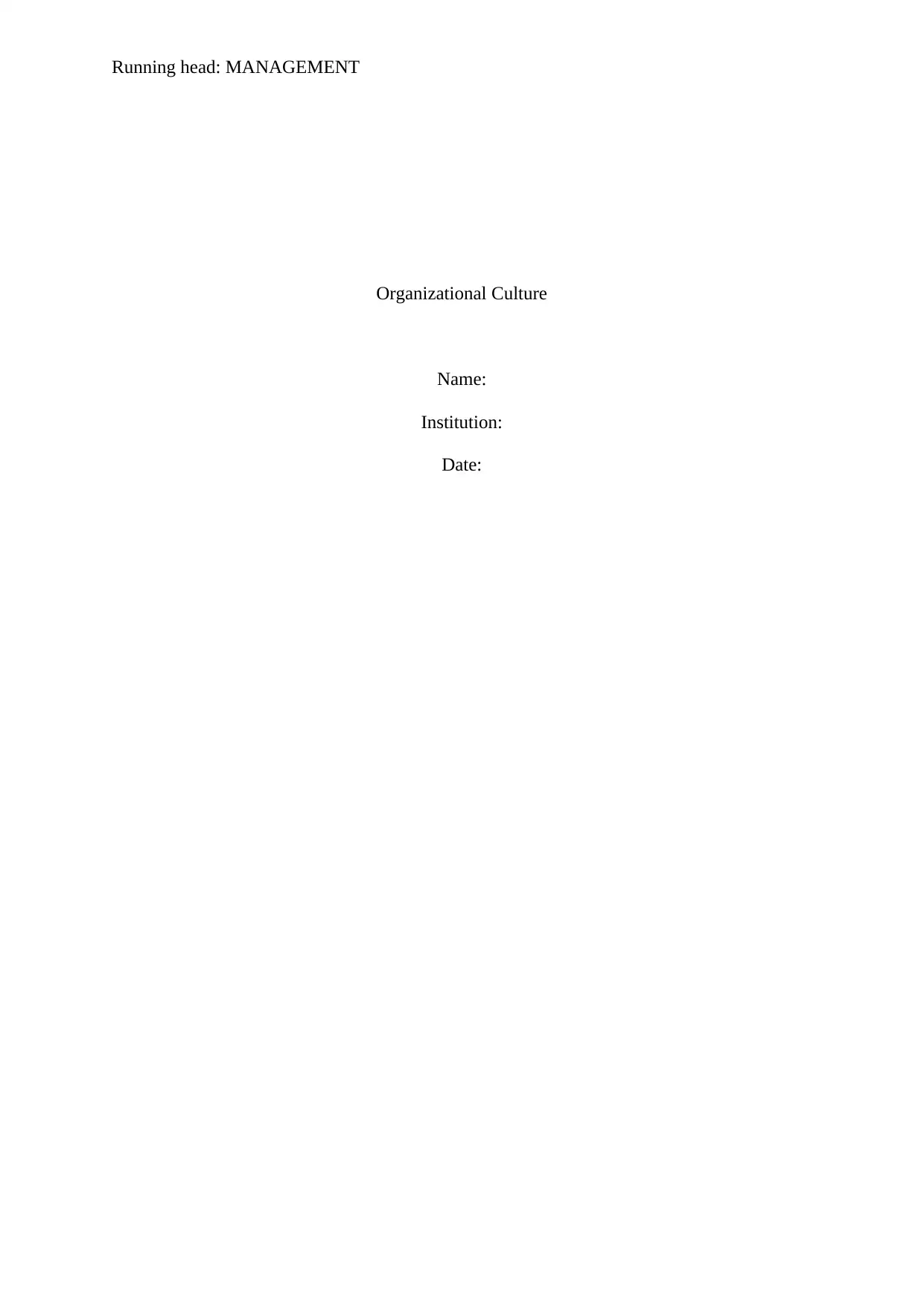
Running head: MANAGEMENT
Organizational Culture
Name:
Institution:
Date:
Organizational Culture
Name:
Institution:
Date:
Paraphrase This Document
Need a fresh take? Get an instant paraphrase of this document with our AI Paraphraser
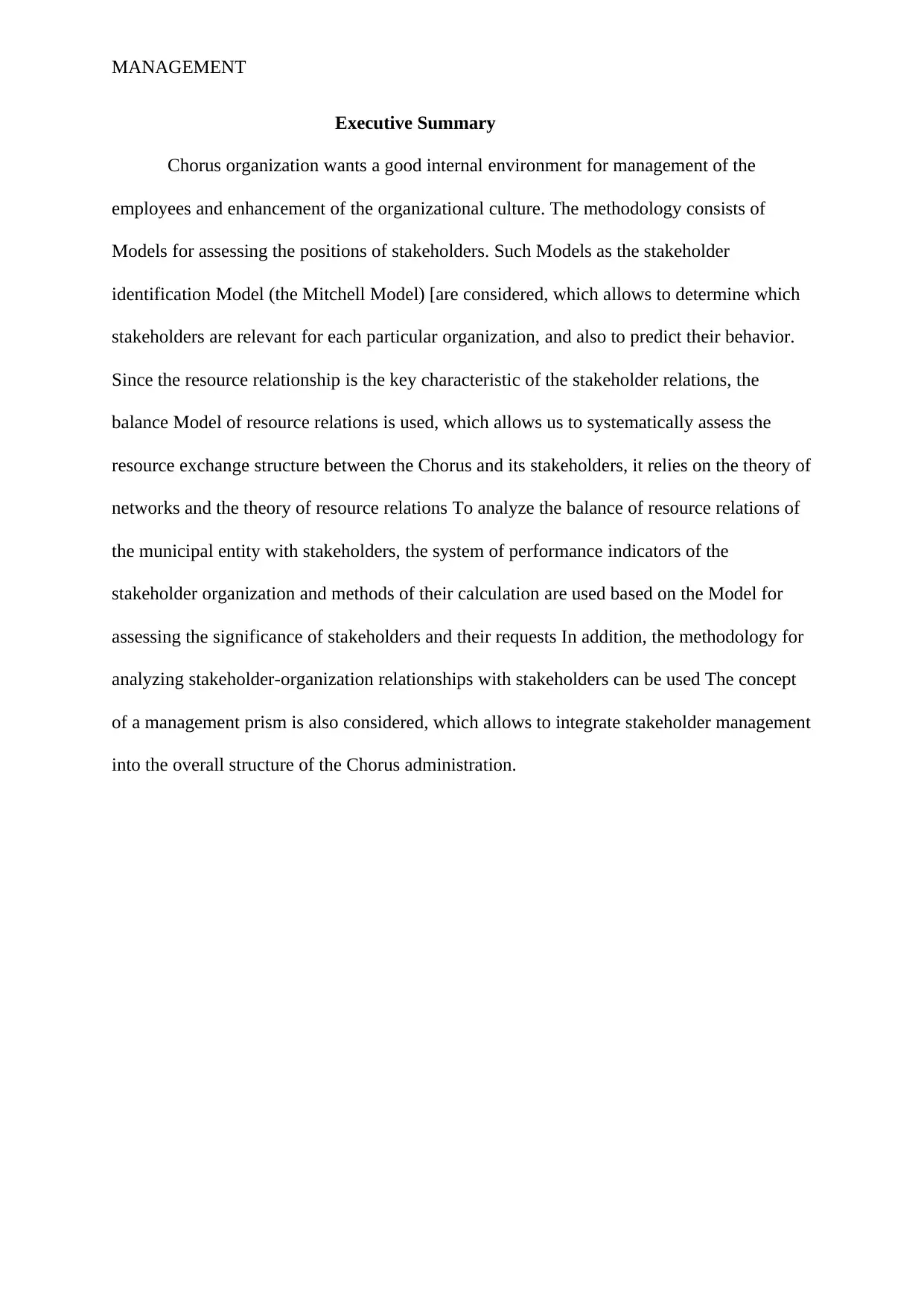
MANAGEMENT
Executive Summary
Chorus organization wants a good internal environment for management of the
employees and enhancement of the organizational culture. The methodology consists of
Models for assessing the positions of stakeholders. Such Models as the stakeholder
identification Model (the Mitchell Model) [are considered, which allows to determine which
stakeholders are relevant for each particular organization, and also to predict their behavior.
Since the resource relationship is the key characteristic of the stakeholder relations, the
balance Model of resource relations is used, which allows us to systematically assess the
resource exchange structure between the Chorus and its stakeholders, it relies on the theory of
networks and the theory of resource relations To analyze the balance of resource relations of
the municipal entity with stakeholders, the system of performance indicators of the
stakeholder organization and methods of their calculation are used based on the Model for
assessing the significance of stakeholders and their requests In addition, the methodology for
analyzing stakeholder-organization relationships with stakeholders can be used The concept
of a management prism is also considered, which allows to integrate stakeholder management
into the overall structure of the Chorus administration.
Executive Summary
Chorus organization wants a good internal environment for management of the
employees and enhancement of the organizational culture. The methodology consists of
Models for assessing the positions of stakeholders. Such Models as the stakeholder
identification Model (the Mitchell Model) [are considered, which allows to determine which
stakeholders are relevant for each particular organization, and also to predict their behavior.
Since the resource relationship is the key characteristic of the stakeholder relations, the
balance Model of resource relations is used, which allows us to systematically assess the
resource exchange structure between the Chorus and its stakeholders, it relies on the theory of
networks and the theory of resource relations To analyze the balance of resource relations of
the municipal entity with stakeholders, the system of performance indicators of the
stakeholder organization and methods of their calculation are used based on the Model for
assessing the significance of stakeholders and their requests In addition, the methodology for
analyzing stakeholder-organization relationships with stakeholders can be used The concept
of a management prism is also considered, which allows to integrate stakeholder management
into the overall structure of the Chorus administration.
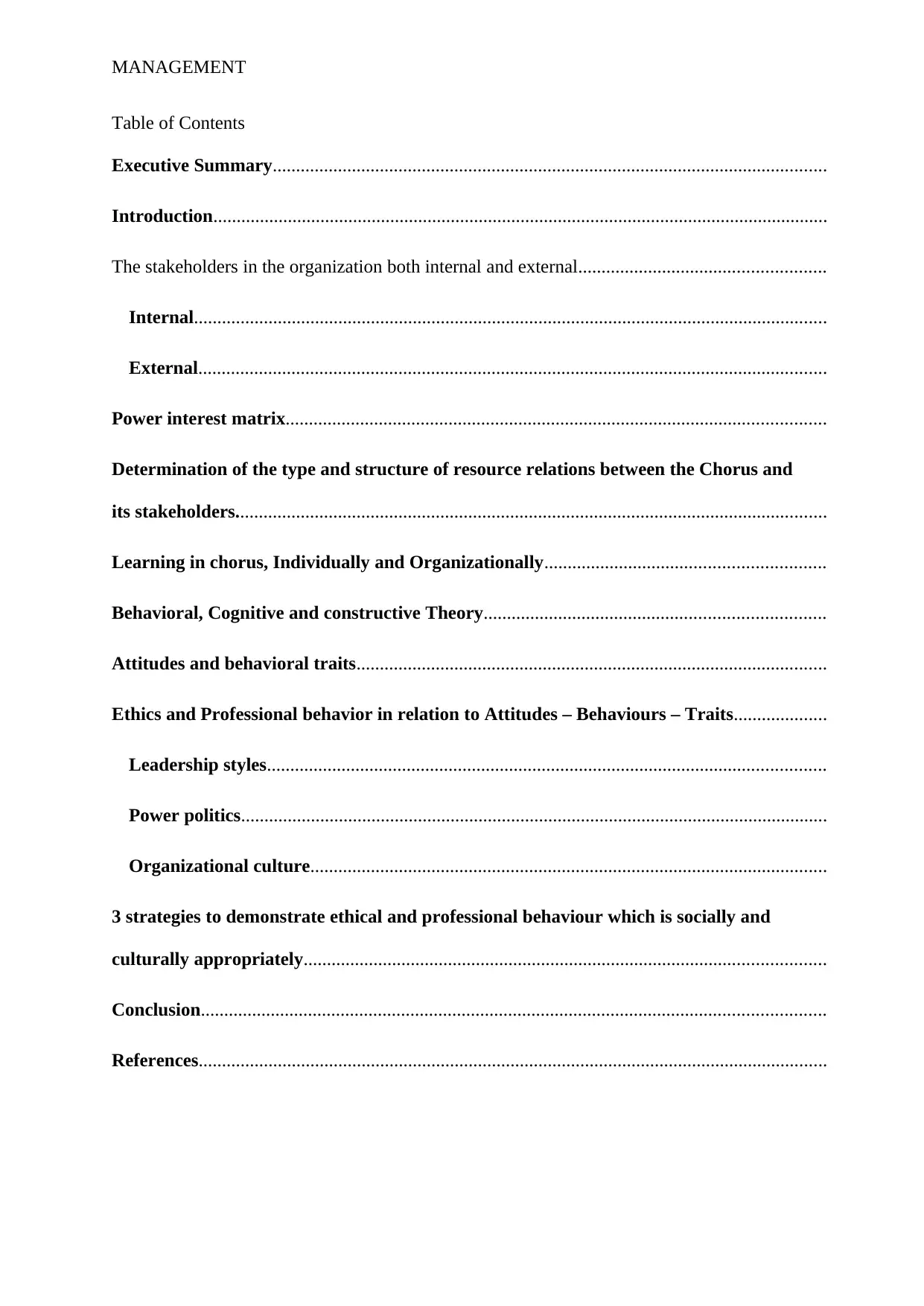
MANAGEMENT
Table of Contents
Executive Summary.......................................................................................................................
Introduction....................................................................................................................................
The stakeholders in the organization both internal and external.....................................................
Internal........................................................................................................................................
External.......................................................................................................................................
Power interest matrix....................................................................................................................
Determination of the type and structure of resource relations between the Chorus and
its stakeholders...............................................................................................................................
Learning in chorus, Individually and Organizationally............................................................
Behavioral, Cognitive and constructive Theory.........................................................................
Attitudes and behavioral traits.....................................................................................................
Ethics and Professional behavior in relation to Attitudes – Behaviours – Traits....................
Leadership styles........................................................................................................................
Power politics..............................................................................................................................
Organizational culture...............................................................................................................
3 strategies to demonstrate ethical and professional behaviour which is socially and
culturally appropriately................................................................................................................
Conclusion......................................................................................................................................
References.......................................................................................................................................
Table of Contents
Executive Summary.......................................................................................................................
Introduction....................................................................................................................................
The stakeholders in the organization both internal and external.....................................................
Internal........................................................................................................................................
External.......................................................................................................................................
Power interest matrix....................................................................................................................
Determination of the type and structure of resource relations between the Chorus and
its stakeholders...............................................................................................................................
Learning in chorus, Individually and Organizationally............................................................
Behavioral, Cognitive and constructive Theory.........................................................................
Attitudes and behavioral traits.....................................................................................................
Ethics and Professional behavior in relation to Attitudes – Behaviours – Traits....................
Leadership styles........................................................................................................................
Power politics..............................................................................................................................
Organizational culture...............................................................................................................
3 strategies to demonstrate ethical and professional behaviour which is socially and
culturally appropriately................................................................................................................
Conclusion......................................................................................................................................
References.......................................................................................................................................
⊘ This is a preview!⊘
Do you want full access?
Subscribe today to unlock all pages.

Trusted by 1+ million students worldwide
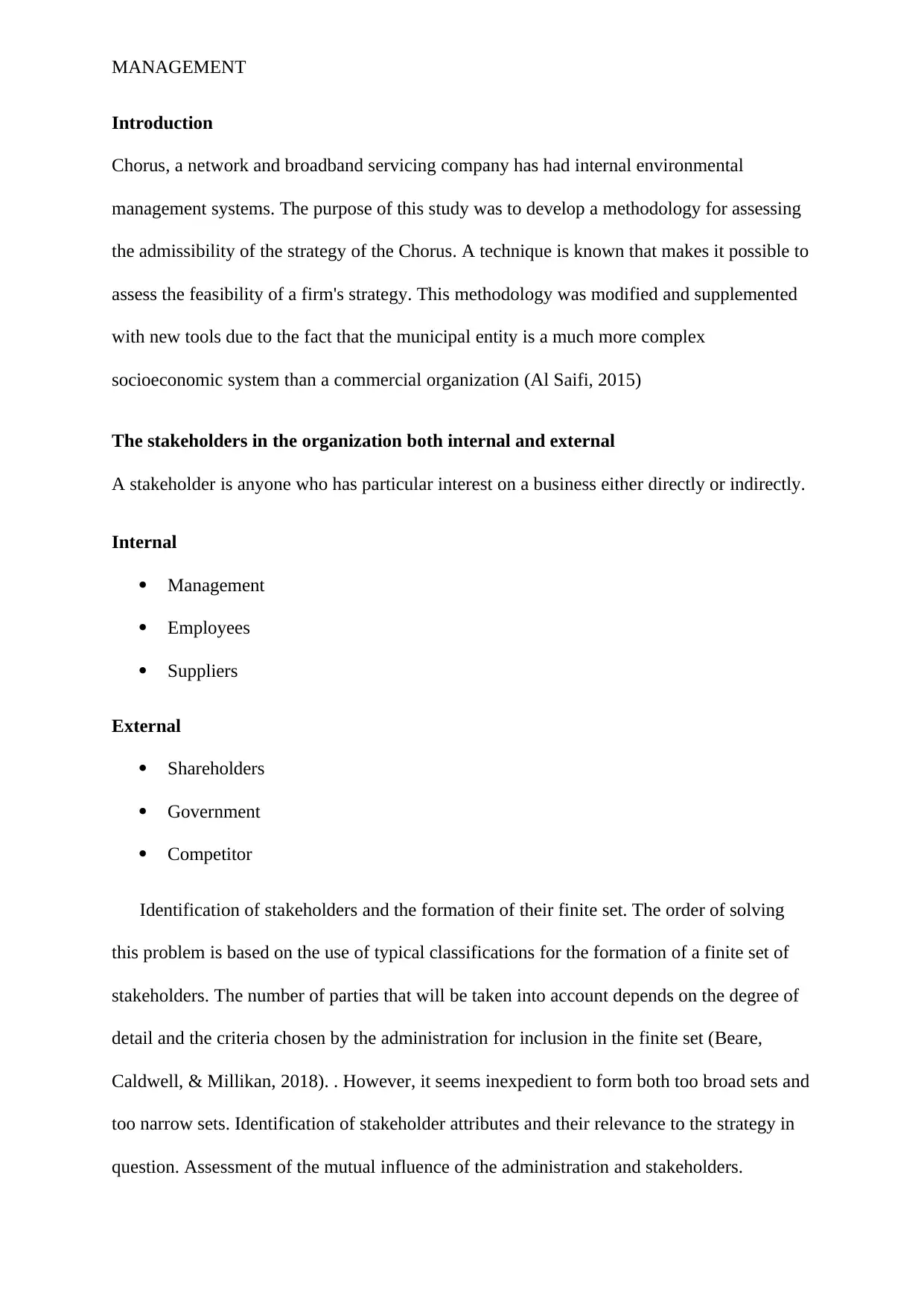
MANAGEMENT
Introduction
Chorus, a network and broadband servicing company has had internal environmental
management systems. The purpose of this study was to develop a methodology for assessing
the admissibility of the strategy of the Chorus. A technique is known that makes it possible to
assess the feasibility of a firm's strategy. This methodology was modified and supplemented
with new tools due to the fact that the municipal entity is a much more complex
socioeconomic system than a commercial organization (Al Saifi, 2015)
The stakeholders in the organization both internal and external
A stakeholder is anyone who has particular interest on a business either directly or indirectly.
Internal
Management
Employees
Suppliers
External
Shareholders
Government
Competitor
Identification of stakeholders and the formation of their finite set. The order of solving
this problem is based on the use of typical classifications for the formation of a finite set of
stakeholders. The number of parties that will be taken into account depends on the degree of
detail and the criteria chosen by the administration for inclusion in the finite set (Beare,
Caldwell, & Millikan, 2018). . However, it seems inexpedient to form both too broad sets and
too narrow sets. Identification of stakeholder attributes and their relevance to the strategy in
question. Assessment of the mutual influence of the administration and stakeholders.
Introduction
Chorus, a network and broadband servicing company has had internal environmental
management systems. The purpose of this study was to develop a methodology for assessing
the admissibility of the strategy of the Chorus. A technique is known that makes it possible to
assess the feasibility of a firm's strategy. This methodology was modified and supplemented
with new tools due to the fact that the municipal entity is a much more complex
socioeconomic system than a commercial organization (Al Saifi, 2015)
The stakeholders in the organization both internal and external
A stakeholder is anyone who has particular interest on a business either directly or indirectly.
Internal
Management
Employees
Suppliers
External
Shareholders
Government
Competitor
Identification of stakeholders and the formation of their finite set. The order of solving
this problem is based on the use of typical classifications for the formation of a finite set of
stakeholders. The number of parties that will be taken into account depends on the degree of
detail and the criteria chosen by the administration for inclusion in the finite set (Beare,
Caldwell, & Millikan, 2018). . However, it seems inexpedient to form both too broad sets and
too narrow sets. Identification of stakeholder attributes and their relevance to the strategy in
question. Assessment of the mutual influence of the administration and stakeholders.
Paraphrase This Document
Need a fresh take? Get an instant paraphrase of this document with our AI Paraphraser
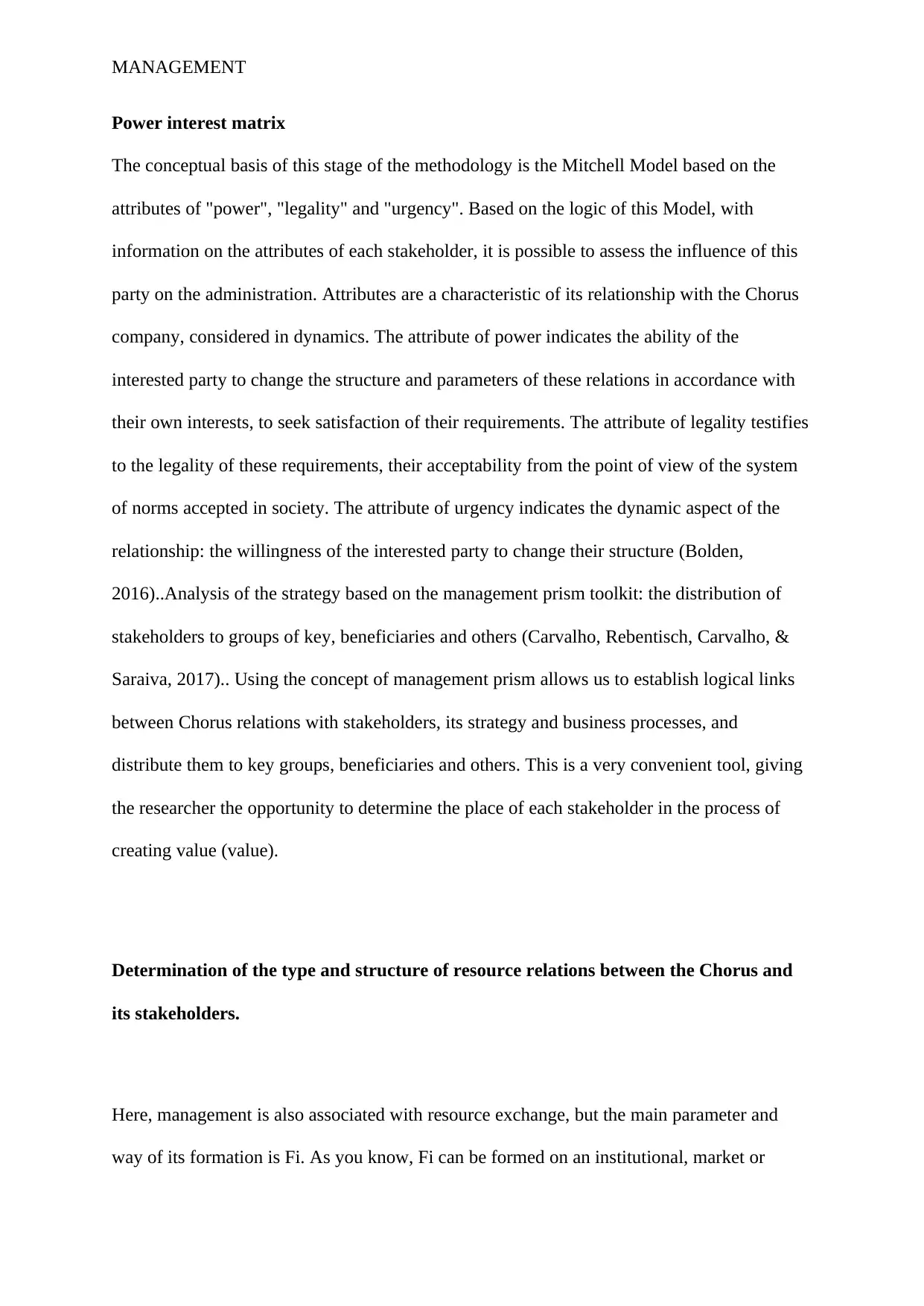
MANAGEMENT
Power interest matrix
The conceptual basis of this stage of the methodology is the Mitchell Model based on the
attributes of "power", "legality" and "urgency". Based on the logic of this Model, with
information on the attributes of each stakeholder, it is possible to assess the influence of this
party on the administration. Attributes are a characteristic of its relationship with the Chorus
company, considered in dynamics. The attribute of power indicates the ability of the
interested party to change the structure and parameters of these relations in accordance with
their own interests, to seek satisfaction of their requirements. The attribute of legality testifies
to the legality of these requirements, their acceptability from the point of view of the system
of norms accepted in society. The attribute of urgency indicates the dynamic aspect of the
relationship: the willingness of the interested party to change their structure (Bolden,
2016)..Analysis of the strategy based on the management prism toolkit: the distribution of
stakeholders to groups of key, beneficiaries and others (Carvalho, Rebentisch, Carvalho, &
Saraiva, 2017).. Using the concept of management prism allows us to establish logical links
between Chorus relations with stakeholders, its strategy and business processes, and
distribute them to key groups, beneficiaries and others. This is a very convenient tool, giving
the researcher the opportunity to determine the place of each stakeholder in the process of
creating value (value).
Determination of the type and structure of resource relations between the Chorus and
its stakeholders.
Here, management is also associated with resource exchange, but the main parameter and
way of its formation is Fi. As you know, Fi can be formed on an institutional, market or
Power interest matrix
The conceptual basis of this stage of the methodology is the Mitchell Model based on the
attributes of "power", "legality" and "urgency". Based on the logic of this Model, with
information on the attributes of each stakeholder, it is possible to assess the influence of this
party on the administration. Attributes are a characteristic of its relationship with the Chorus
company, considered in dynamics. The attribute of power indicates the ability of the
interested party to change the structure and parameters of these relations in accordance with
their own interests, to seek satisfaction of their requirements. The attribute of legality testifies
to the legality of these requirements, their acceptability from the point of view of the system
of norms accepted in society. The attribute of urgency indicates the dynamic aspect of the
relationship: the willingness of the interested party to change their structure (Bolden,
2016)..Analysis of the strategy based on the management prism toolkit: the distribution of
stakeholders to groups of key, beneficiaries and others (Carvalho, Rebentisch, Carvalho, &
Saraiva, 2017).. Using the concept of management prism allows us to establish logical links
between Chorus relations with stakeholders, its strategy and business processes, and
distribute them to key groups, beneficiaries and others. This is a very convenient tool, giving
the researcher the opportunity to determine the place of each stakeholder in the process of
creating value (value).
Determination of the type and structure of resource relations between the Chorus and
its stakeholders.
Here, management is also associated with resource exchange, but the main parameter and
way of its formation is Fi. As you know, Fi can be formed on an institutional, market or
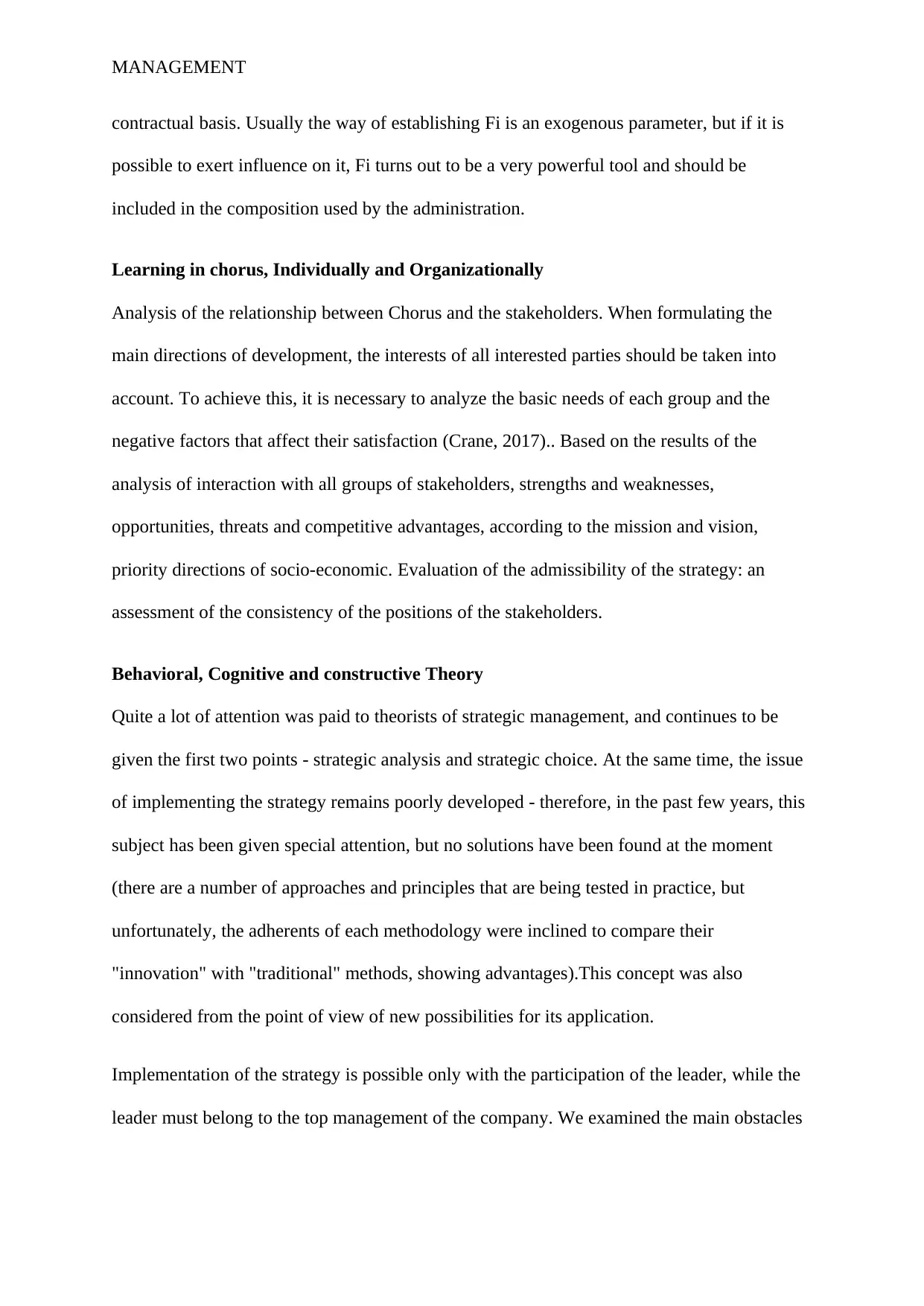
MANAGEMENT
contractual basis. Usually the way of establishing Fi is an exogenous parameter, but if it is
possible to exert influence on it, Fi turns out to be a very powerful tool and should be
included in the composition used by the administration.
Learning in chorus, Individually and Organizationally
Analysis of the relationship between Chorus and the stakeholders. When formulating the
main directions of development, the interests of all interested parties should be taken into
account. To achieve this, it is necessary to analyze the basic needs of each group and the
negative factors that affect their satisfaction (Crane, 2017).. Based on the results of the
analysis of interaction with all groups of stakeholders, strengths and weaknesses,
opportunities, threats and competitive advantages, according to the mission and vision,
priority directions of socio-economic. Evaluation of the admissibility of the strategy: an
assessment of the consistency of the positions of the stakeholders.
Behavioral, Cognitive and constructive Theory
Quite a lot of attention was paid to theorists of strategic management, and continues to be
given the first two points - strategic analysis and strategic choice. At the same time, the issue
of implementing the strategy remains poorly developed - therefore, in the past few years, this
subject has been given special attention, but no solutions have been found at the moment
(there are a number of approaches and principles that are being tested in practice, but
unfortunately, the adherents of each methodology were inclined to compare their
"innovation" with "traditional" methods, showing advantages).This concept was also
considered from the point of view of new possibilities for its application.
Implementation of the strategy is possible only with the participation of the leader, while the
leader must belong to the top management of the company. We examined the main obstacles
contractual basis. Usually the way of establishing Fi is an exogenous parameter, but if it is
possible to exert influence on it, Fi turns out to be a very powerful tool and should be
included in the composition used by the administration.
Learning in chorus, Individually and Organizationally
Analysis of the relationship between Chorus and the stakeholders. When formulating the
main directions of development, the interests of all interested parties should be taken into
account. To achieve this, it is necessary to analyze the basic needs of each group and the
negative factors that affect their satisfaction (Crane, 2017).. Based on the results of the
analysis of interaction with all groups of stakeholders, strengths and weaknesses,
opportunities, threats and competitive advantages, according to the mission and vision,
priority directions of socio-economic. Evaluation of the admissibility of the strategy: an
assessment of the consistency of the positions of the stakeholders.
Behavioral, Cognitive and constructive Theory
Quite a lot of attention was paid to theorists of strategic management, and continues to be
given the first two points - strategic analysis and strategic choice. At the same time, the issue
of implementing the strategy remains poorly developed - therefore, in the past few years, this
subject has been given special attention, but no solutions have been found at the moment
(there are a number of approaches and principles that are being tested in practice, but
unfortunately, the adherents of each methodology were inclined to compare their
"innovation" with "traditional" methods, showing advantages).This concept was also
considered from the point of view of new possibilities for its application.
Implementation of the strategy is possible only with the participation of the leader, while the
leader must belong to the top management of the company. We examined the main obstacles
⊘ This is a preview!⊘
Do you want full access?
Subscribe today to unlock all pages.

Trusted by 1+ million students worldwide
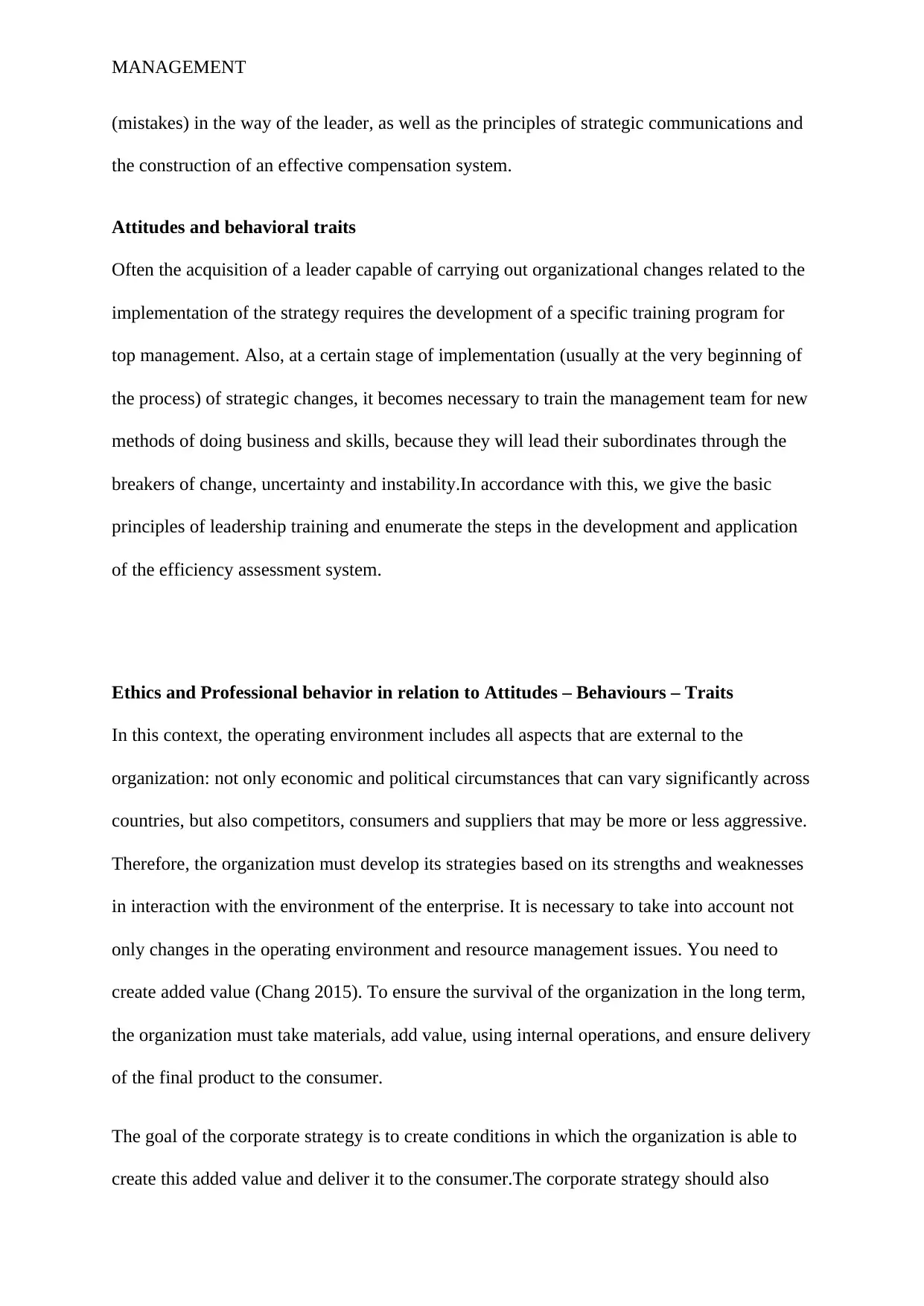
MANAGEMENT
(mistakes) in the way of the leader, as well as the principles of strategic communications and
the construction of an effective compensation system.
Attitudes and behavioral traits
Often the acquisition of a leader capable of carrying out organizational changes related to the
implementation of the strategy requires the development of a specific training program for
top management. Also, at a certain stage of implementation (usually at the very beginning of
the process) of strategic changes, it becomes necessary to train the management team for new
methods of doing business and skills, because they will lead their subordinates through the
breakers of change, uncertainty and instability.In accordance with this, we give the basic
principles of leadership training and enumerate the steps in the development and application
of the efficiency assessment system.
Ethics and Professional behavior in relation to Attitudes – Behaviours – Traits
In this context, the operating environment includes all aspects that are external to the
organization: not only economic and political circumstances that can vary significantly across
countries, but also competitors, consumers and suppliers that may be more or less aggressive.
Therefore, the organization must develop its strategies based on its strengths and weaknesses
in interaction with the environment of the enterprise. It is necessary to take into account not
only changes in the operating environment and resource management issues. You need to
create added value (Chang 2015). To ensure the survival of the organization in the long term,
the organization must take materials, add value, using internal operations, and ensure delivery
of the final product to the consumer.
The goal of the corporate strategy is to create conditions in which the organization is able to
create this added value and deliver it to the consumer.The corporate strategy should also
(mistakes) in the way of the leader, as well as the principles of strategic communications and
the construction of an effective compensation system.
Attitudes and behavioral traits
Often the acquisition of a leader capable of carrying out organizational changes related to the
implementation of the strategy requires the development of a specific training program for
top management. Also, at a certain stage of implementation (usually at the very beginning of
the process) of strategic changes, it becomes necessary to train the management team for new
methods of doing business and skills, because they will lead their subordinates through the
breakers of change, uncertainty and instability.In accordance with this, we give the basic
principles of leadership training and enumerate the steps in the development and application
of the efficiency assessment system.
Ethics and Professional behavior in relation to Attitudes – Behaviours – Traits
In this context, the operating environment includes all aspects that are external to the
organization: not only economic and political circumstances that can vary significantly across
countries, but also competitors, consumers and suppliers that may be more or less aggressive.
Therefore, the organization must develop its strategies based on its strengths and weaknesses
in interaction with the environment of the enterprise. It is necessary to take into account not
only changes in the operating environment and resource management issues. You need to
create added value (Chang 2015). To ensure the survival of the organization in the long term,
the organization must take materials, add value, using internal operations, and ensure delivery
of the final product to the consumer.
The goal of the corporate strategy is to create conditions in which the organization is able to
create this added value and deliver it to the consumer.The corporate strategy should also
Paraphrase This Document
Need a fresh take? Get an instant paraphrase of this document with our AI Paraphraser
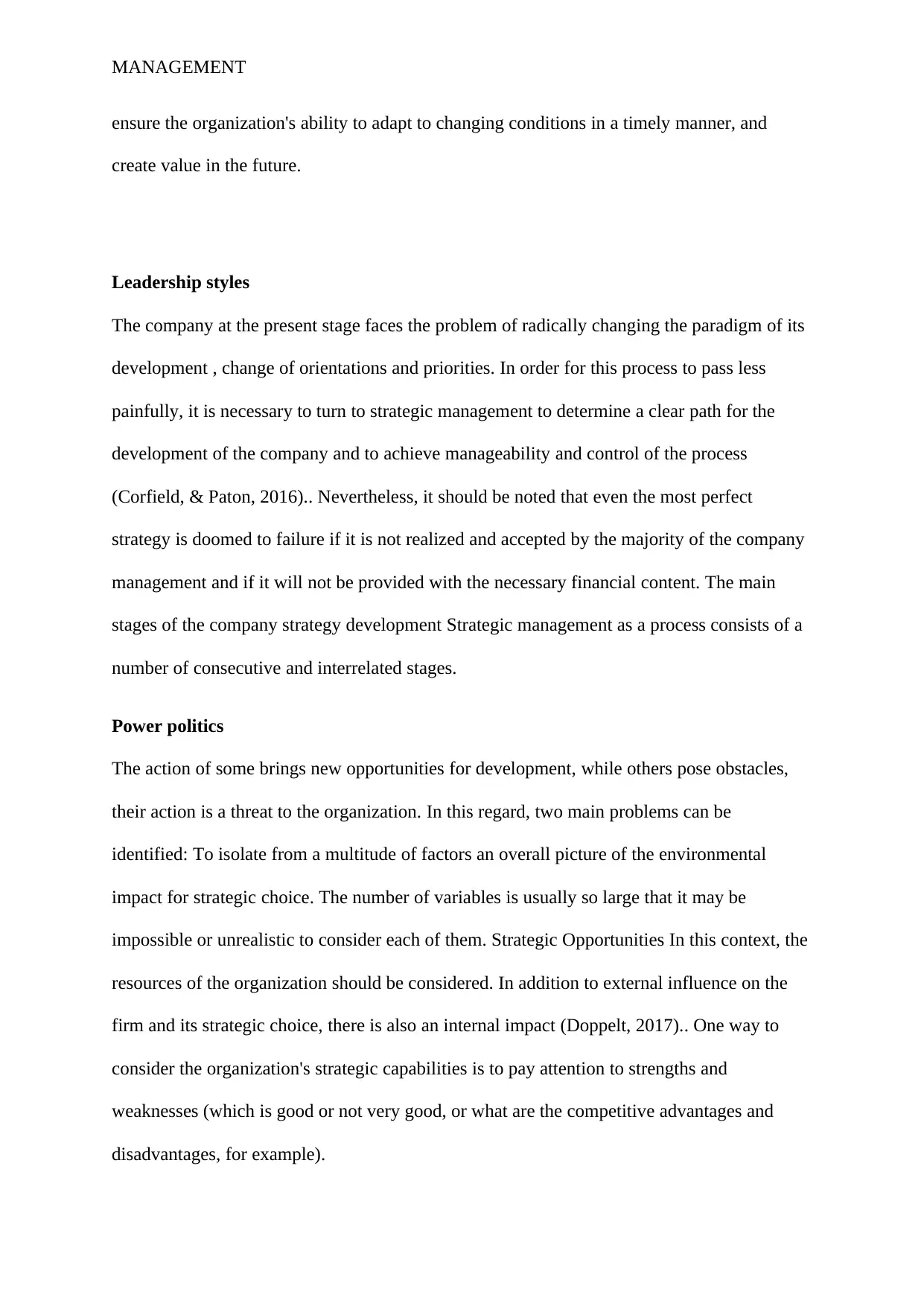
MANAGEMENT
ensure the organization's ability to adapt to changing conditions in a timely manner, and
create value in the future.
Leadership styles
The company at the present stage faces the problem of radically changing the paradigm of its
development , change of orientations and priorities. In order for this process to pass less
painfully, it is necessary to turn to strategic management to determine a clear path for the
development of the company and to achieve manageability and control of the process
(Corfield, & Paton, 2016).. Nevertheless, it should be noted that even the most perfect
strategy is doomed to failure if it is not realized and accepted by the majority of the company
management and if it will not be provided with the necessary financial content. The main
stages of the company strategy development Strategic management as a process consists of a
number of consecutive and interrelated stages.
Power politics
The action of some brings new opportunities for development, while others pose obstacles,
their action is a threat to the organization. In this regard, two main problems can be
identified: To isolate from a multitude of factors an overall picture of the environmental
impact for strategic choice. The number of variables is usually so large that it may be
impossible or unrealistic to consider each of them. Strategic Opportunities In this context, the
resources of the organization should be considered. In addition to external influence on the
firm and its strategic choice, there is also an internal impact (Doppelt, 2017).. One way to
consider the organization's strategic capabilities is to pay attention to strengths and
weaknesses (which is good or not very good, or what are the competitive advantages and
disadvantages, for example).
ensure the organization's ability to adapt to changing conditions in a timely manner, and
create value in the future.
Leadership styles
The company at the present stage faces the problem of radically changing the paradigm of its
development , change of orientations and priorities. In order for this process to pass less
painfully, it is necessary to turn to strategic management to determine a clear path for the
development of the company and to achieve manageability and control of the process
(Corfield, & Paton, 2016).. Nevertheless, it should be noted that even the most perfect
strategy is doomed to failure if it is not realized and accepted by the majority of the company
management and if it will not be provided with the necessary financial content. The main
stages of the company strategy development Strategic management as a process consists of a
number of consecutive and interrelated stages.
Power politics
The action of some brings new opportunities for development, while others pose obstacles,
their action is a threat to the organization. In this regard, two main problems can be
identified: To isolate from a multitude of factors an overall picture of the environmental
impact for strategic choice. The number of variables is usually so large that it may be
impossible or unrealistic to consider each of them. Strategic Opportunities In this context, the
resources of the organization should be considered. In addition to external influence on the
firm and its strategic choice, there is also an internal impact (Doppelt, 2017).. One way to
consider the organization's strategic capabilities is to pay attention to strengths and
weaknesses (which is good or not very good, or what are the competitive advantages and
disadvantages, for example).
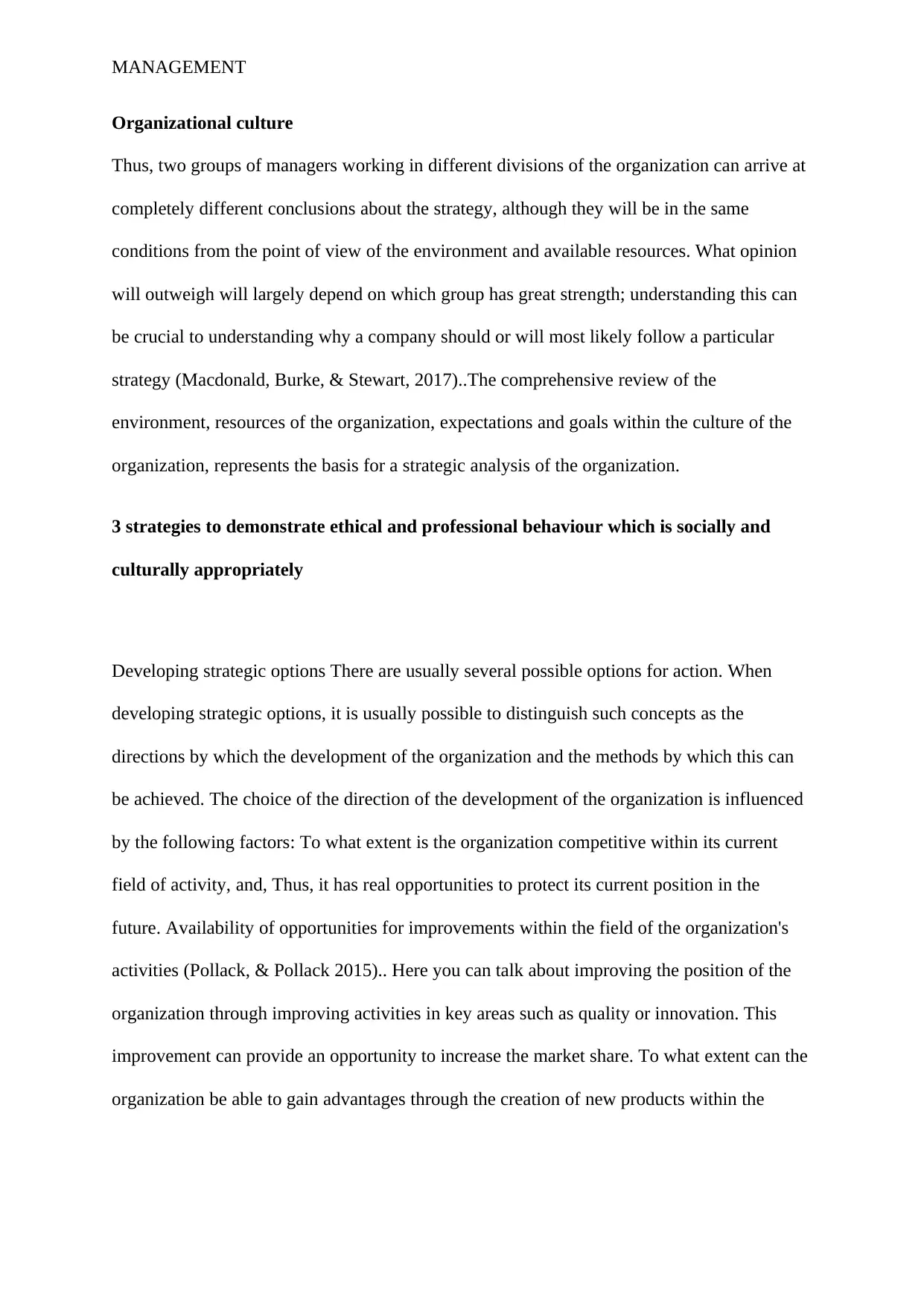
MANAGEMENT
Organizational culture
Thus, two groups of managers working in different divisions of the organization can arrive at
completely different conclusions about the strategy, although they will be in the same
conditions from the point of view of the environment and available resources. What opinion
will outweigh will largely depend on which group has great strength; understanding this can
be crucial to understanding why a company should or will most likely follow a particular
strategy (Macdonald, Burke, & Stewart, 2017)..The comprehensive review of the
environment, resources of the organization, expectations and goals within the culture of the
organization, represents the basis for a strategic analysis of the organization.
3 strategies to demonstrate ethical and professional behaviour which is socially and
culturally appropriately
Developing strategic options There are usually several possible options for action. When
developing strategic options, it is usually possible to distinguish such concepts as the
directions by which the development of the organization and the methods by which this can
be achieved. The choice of the direction of the development of the organization is influenced
by the following factors: To what extent is the organization competitive within its current
field of activity, and, Thus, it has real opportunities to protect its current position in the
future. Availability of opportunities for improvements within the field of the organization's
activities (Pollack, & Pollack 2015).. Here you can talk about improving the position of the
organization through improving activities in key areas such as quality or innovation. This
improvement can provide an opportunity to increase the market share. To what extent can the
organization be able to gain advantages through the creation of new products within the
Organizational culture
Thus, two groups of managers working in different divisions of the organization can arrive at
completely different conclusions about the strategy, although they will be in the same
conditions from the point of view of the environment and available resources. What opinion
will outweigh will largely depend on which group has great strength; understanding this can
be crucial to understanding why a company should or will most likely follow a particular
strategy (Macdonald, Burke, & Stewart, 2017)..The comprehensive review of the
environment, resources of the organization, expectations and goals within the culture of the
organization, represents the basis for a strategic analysis of the organization.
3 strategies to demonstrate ethical and professional behaviour which is socially and
culturally appropriately
Developing strategic options There are usually several possible options for action. When
developing strategic options, it is usually possible to distinguish such concepts as the
directions by which the development of the organization and the methods by which this can
be achieved. The choice of the direction of the development of the organization is influenced
by the following factors: To what extent is the organization competitive within its current
field of activity, and, Thus, it has real opportunities to protect its current position in the
future. Availability of opportunities for improvements within the field of the organization's
activities (Pollack, & Pollack 2015).. Here you can talk about improving the position of the
organization through improving activities in key areas such as quality or innovation. This
improvement can provide an opportunity to increase the market share. To what extent can the
organization be able to gain advantages through the creation of new products within the
⊘ This is a preview!⊘
Do you want full access?
Subscribe today to unlock all pages.

Trusted by 1+ million students worldwide
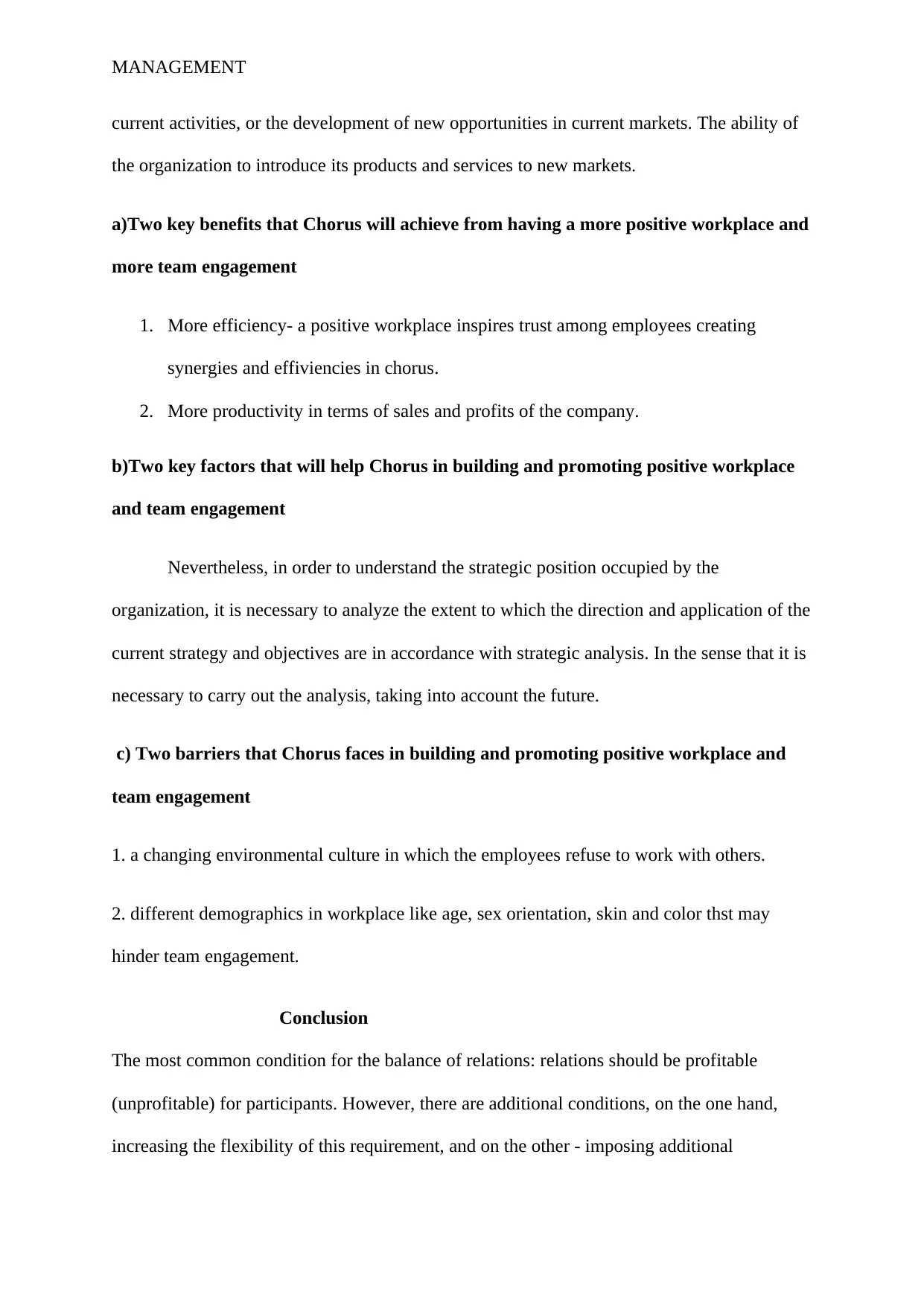
MANAGEMENT
current activities, or the development of new opportunities in current markets. The ability of
the organization to introduce its products and services to new markets.
a)Two key benefits that Chorus will achieve from having a more positive workplace and
more team engagement
1. More efficiency- a positive workplace inspires trust among employees creating
synergies and effiviencies in chorus.
2. More productivity in terms of sales and profits of the company.
b)Two key factors that will help Chorus in building and promoting positive workplace
and team engagement
Nevertheless, in order to understand the strategic position occupied by the
organization, it is necessary to analyze the extent to which the direction and application of the
current strategy and objectives are in accordance with strategic analysis. In the sense that it is
necessary to carry out the analysis, taking into account the future.
c) Two barriers that Chorus faces in building and promoting positive workplace and
team engagement
1. a changing environmental culture in which the employees refuse to work with others.
2. different demographics in workplace like age, sex orientation, skin and color thst may
hinder team engagement.
Conclusion
The most common condition for the balance of relations: relations should be profitable
(unprofitable) for participants. However, there are additional conditions, on the one hand,
increasing the flexibility of this requirement, and on the other - imposing additional
current activities, or the development of new opportunities in current markets. The ability of
the organization to introduce its products and services to new markets.
a)Two key benefits that Chorus will achieve from having a more positive workplace and
more team engagement
1. More efficiency- a positive workplace inspires trust among employees creating
synergies and effiviencies in chorus.
2. More productivity in terms of sales and profits of the company.
b)Two key factors that will help Chorus in building and promoting positive workplace
and team engagement
Nevertheless, in order to understand the strategic position occupied by the
organization, it is necessary to analyze the extent to which the direction and application of the
current strategy and objectives are in accordance with strategic analysis. In the sense that it is
necessary to carry out the analysis, taking into account the future.
c) Two barriers that Chorus faces in building and promoting positive workplace and
team engagement
1. a changing environmental culture in which the employees refuse to work with others.
2. different demographics in workplace like age, sex orientation, skin and color thst may
hinder team engagement.
Conclusion
The most common condition for the balance of relations: relations should be profitable
(unprofitable) for participants. However, there are additional conditions, on the one hand,
increasing the flexibility of this requirement, and on the other - imposing additional
Paraphrase This Document
Need a fresh take? Get an instant paraphrase of this document with our AI Paraphraser
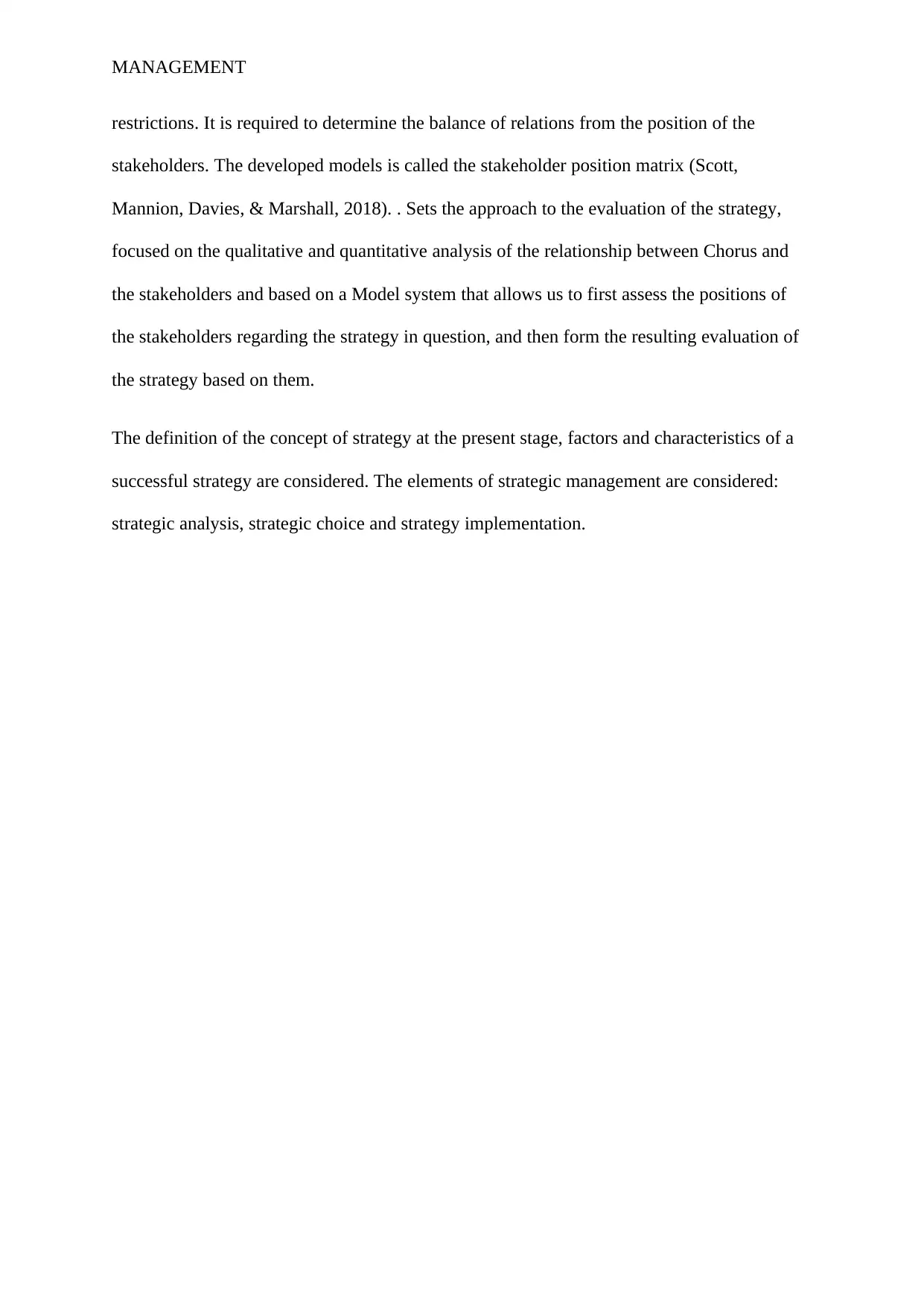
MANAGEMENT
restrictions. It is required to determine the balance of relations from the position of the
stakeholders. The developed models is called the stakeholder position matrix (Scott,
Mannion, Davies, & Marshall, 2018). . Sets the approach to the evaluation of the strategy,
focused on the qualitative and quantitative analysis of the relationship between Chorus and
the stakeholders and based on a Model system that allows us to first assess the positions of
the stakeholders regarding the strategy in question, and then form the resulting evaluation of
the strategy based on them.
The definition of the concept of strategy at the present stage, factors and characteristics of a
successful strategy are considered. The elements of strategic management are considered:
strategic analysis, strategic choice and strategy implementation.
restrictions. It is required to determine the balance of relations from the position of the
stakeholders. The developed models is called the stakeholder position matrix (Scott,
Mannion, Davies, & Marshall, 2018). . Sets the approach to the evaluation of the strategy,
focused on the qualitative and quantitative analysis of the relationship between Chorus and
the stakeholders and based on a Model system that allows us to first assess the positions of
the stakeholders regarding the strategy in question, and then form the resulting evaluation of
the strategy based on them.
The definition of the concept of strategy at the present stage, factors and characteristics of a
successful strategy are considered. The elements of strategic management are considered:
strategic analysis, strategic choice and strategy implementation.
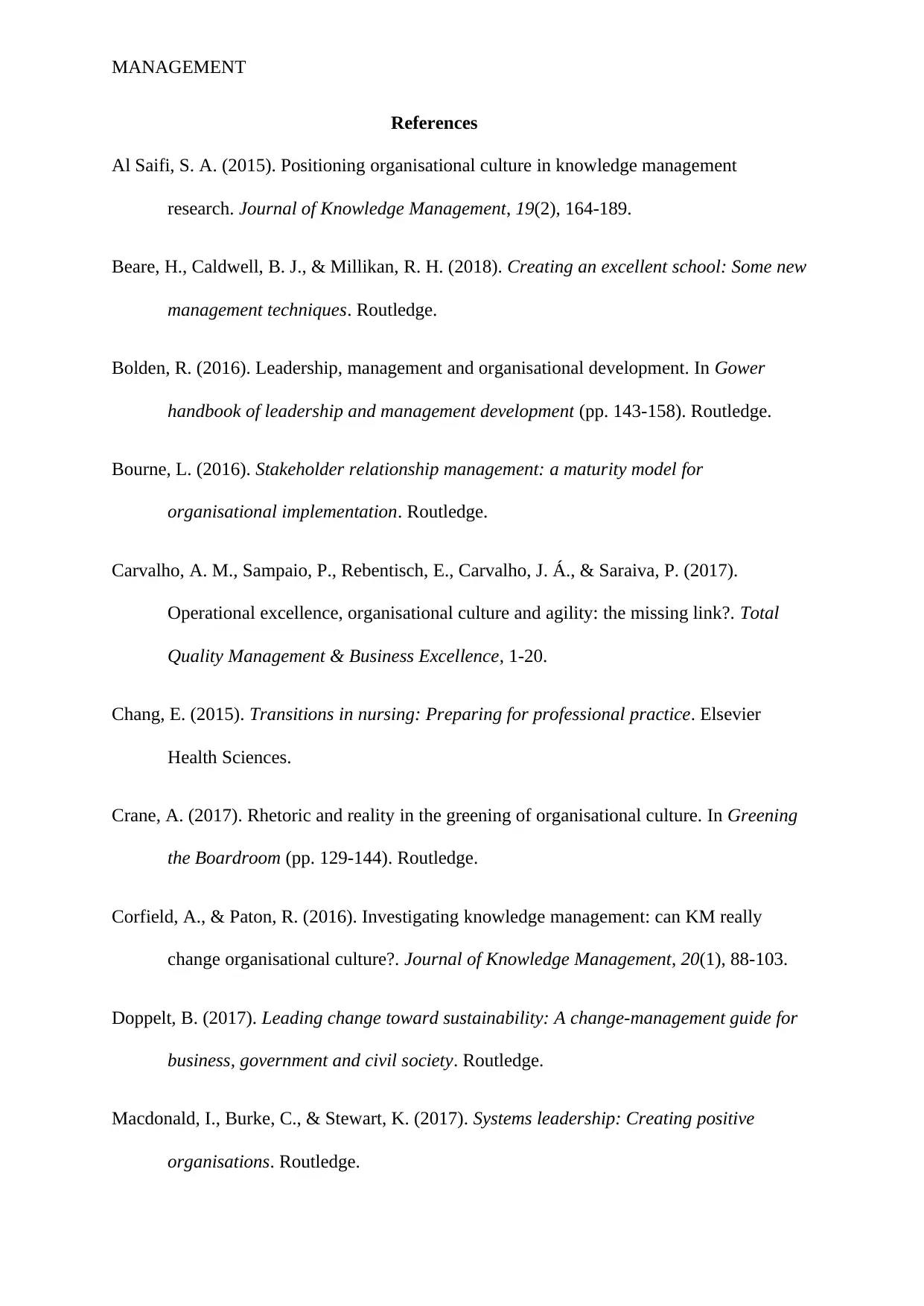
MANAGEMENT
References
Al Saifi, S. A. (2015). Positioning organisational culture in knowledge management
research. Journal of Knowledge Management, 19(2), 164-189.
Beare, H., Caldwell, B. J., & Millikan, R. H. (2018). Creating an excellent school: Some new
management techniques. Routledge.
Bolden, R. (2016). Leadership, management and organisational development. In Gower
handbook of leadership and management development (pp. 143-158). Routledge.
Bourne, L. (2016). Stakeholder relationship management: a maturity model for
organisational implementation. Routledge.
Carvalho, A. M., Sampaio, P., Rebentisch, E., Carvalho, J. Á., & Saraiva, P. (2017).
Operational excellence, organisational culture and agility: the missing link?. Total
Quality Management & Business Excellence, 1-20.
Chang, E. (2015). Transitions in nursing: Preparing for professional practice. Elsevier
Health Sciences.
Crane, A. (2017). Rhetoric and reality in the greening of organisational culture. In Greening
the Boardroom (pp. 129-144). Routledge.
Corfield, A., & Paton, R. (2016). Investigating knowledge management: can KM really
change organisational culture?. Journal of Knowledge Management, 20(1), 88-103.
Doppelt, B. (2017). Leading change toward sustainability: A change-management guide for
business, government and civil society. Routledge.
Macdonald, I., Burke, C., & Stewart, K. (2017). Systems leadership: Creating positive
organisations. Routledge.
References
Al Saifi, S. A. (2015). Positioning organisational culture in knowledge management
research. Journal of Knowledge Management, 19(2), 164-189.
Beare, H., Caldwell, B. J., & Millikan, R. H. (2018). Creating an excellent school: Some new
management techniques. Routledge.
Bolden, R. (2016). Leadership, management and organisational development. In Gower
handbook of leadership and management development (pp. 143-158). Routledge.
Bourne, L. (2016). Stakeholder relationship management: a maturity model for
organisational implementation. Routledge.
Carvalho, A. M., Sampaio, P., Rebentisch, E., Carvalho, J. Á., & Saraiva, P. (2017).
Operational excellence, organisational culture and agility: the missing link?. Total
Quality Management & Business Excellence, 1-20.
Chang, E. (2015). Transitions in nursing: Preparing for professional practice. Elsevier
Health Sciences.
Crane, A. (2017). Rhetoric and reality in the greening of organisational culture. In Greening
the Boardroom (pp. 129-144). Routledge.
Corfield, A., & Paton, R. (2016). Investigating knowledge management: can KM really
change organisational culture?. Journal of Knowledge Management, 20(1), 88-103.
Doppelt, B. (2017). Leading change toward sustainability: A change-management guide for
business, government and civil society. Routledge.
Macdonald, I., Burke, C., & Stewart, K. (2017). Systems leadership: Creating positive
organisations. Routledge.
⊘ This is a preview!⊘
Do you want full access?
Subscribe today to unlock all pages.

Trusted by 1+ million students worldwide
1 out of 13
Related Documents
Your All-in-One AI-Powered Toolkit for Academic Success.
+13062052269
info@desklib.com
Available 24*7 on WhatsApp / Email
![[object Object]](/_next/static/media/star-bottom.7253800d.svg)
Unlock your academic potential
Copyright © 2020–2025 A2Z Services. All Rights Reserved. Developed and managed by ZUCOL.





